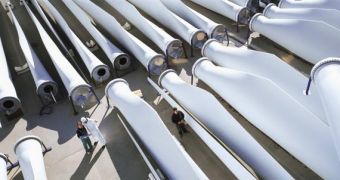Eleven Spanish companies are joining forces into building an 15-MW offshore wind turbine – or the Azimut Project as it is called, a project that should be using 100% Spanish technology.
This project will need an overall investment of 25 million euros, over a four-year period, and it will be co-financed by the participating companies.
The Azimut Offshore Wind Energy 2020 project has been approved by the Center for the Development of Industrial Technology (CDTI), a unit of the Science and Innovation Ministry via the Cenit (National Strategic Consortium in Technical Research) Program.
At this adventure will take part 11 companies and 22 research centers, all specialized in offshore wind energy technology, whose purpose is to realize the Azimut Offshore Wind Energy 2020 project, by developing a large-scale marine wind turbine using 100% Spanish technology.
The entire project will be led by Gamesa, and will involve 10 other companies, out of which lead partners Alstom Wind, Iberdrola Renovables, Acciona Windpower and Acciona Energía, along with other participants like Técnicas Reunidas, Ingeciber, Ingeteam, Imatia, Tecnitest Ingenieros and DIgSILENT Ibérica.
Concerning the technological areas the project will be focusing on, the tasks are divided: Gamesa will take care of all activities including the offshore wind energy capture and Alstom Wind will manage the marine structure and substructure segment.
Acciona Windpower will be responsible for electricity conversion technologies, Acciona Energía will lead construction, operation and maintenance at offshore sites, and Iberdrola Renovables will manage the integration of offshore wind energy into the electricity grid.
This titanesque mission should be finished in 2013, when it will represent the technological base for the further development (around 2020) of a large-scale offshore wind turbine.
Azimut's initial goal was developing a turbine with unit capacity of 15 MW, strong enough to overcome all technical and financial obstacles that currently limit the inauguration of offshore wind energy, like availability, turbine foundations and energy delivery to land, as well as reducing the gap between offshore energy’s cost and required investment and those of onshore wind energy sites.

 14 DAY TRIAL //
14 DAY TRIAL //